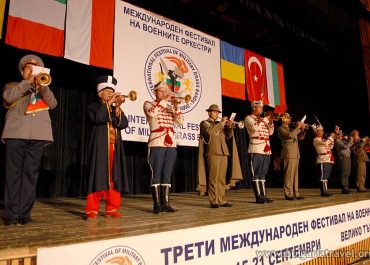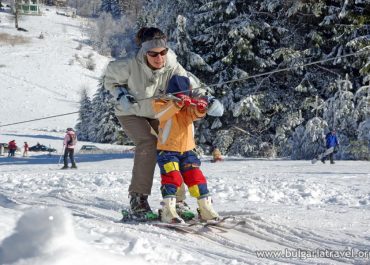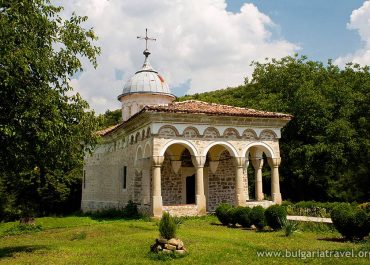
Archaeological Museum – Veliko Tarnovo
The Archaeological Museum of Veliko Tarnovo presents the Tarnovgrad – Capital of Bulgaria in the 12th – 14th Centuries Exhibition. The archaeological monuments which are part of it demonstrate the millennial history and culture of the Veliko Tarnovo Region. Special attention is devoted to the period when the town was the capital of the medieval Bulgarian state.
The first museum hall follows the development of the life of the people who settled in the region in ancient times. Exhibits such as pottery vessels, tools, weapons, religious sculptures, etc., attract the visitors’ attention. They were discovered in the town tumulus at Samovodene Village, in the settlement in Kachitsa Area, in Veliko Tarnovo, in Dzhulyunitsa, in the town tumulus at Hotnitsa Village, in the settlement near Hotnitsa Waterfall, and in the Thracian settlement on Tsarevets Hill. The oldest exhibits date back to 5800 BC.
A few unique exhibits are also displayed: a bottom of a pottery vessel from the Neolithic Age featuring symbols of a pre-writing system, a gold treasure from the Chalcolithic Age found in Hotnitsa Village, gold adornments from the Chalcolithic Age found in the cave near Emen Village, four general finds of tools and weapons from the Bronze Age and finds discovered in the Thracian tomb at Izgrev Village (Sunrise Village).
The exhibition in the second hall reveals the history of the urban, military, administrative and economic centres that emerged during Antiquity and their place in the cultural and historical heritage of Bulgaria. The big urban centre Nicopolis ad Istrum, the Nove Roman military camp near Svishtov, the centres for the production of pottery art, pottery vessels, and building ceramics at Pavlikeni, Butovo, Hotnitsa, Byala cherkva (White Church), the Peritensium and Discoduraterae emporiums, the early-Byzantine town situated on Tsarevets Hill and Momina krepost Hill (Maiden’s Fortress Hill) are all represented in the exhibition. Most impressive are the collection of pottery vessels and casts from the 2nd – 4th centuries BC, the votive tablets depicting ancient Greek, Thracian and Roman deities, the bronze sculptures, the engraved gems and cameos made of precious and semi-precious stones, the adornments, etc.
Exhibits demonstrating the culture of the time when Tarnovgrad was capital of the medieval Bulgarian state (12th – 14th centuries) can be found in the third hall. Visitors can see gold and lead seals affixed to royal letters and correspondence, gold seal-rings of Bulgarian dignitaries, coins depicting Bulgarian rulers, adornments, arms, architectural elements and building ceramics, items made by craftsmen, a collection of pottery vessels, items of Eastern and Western European origin that ended up in the capital town thanks to its trade connections, literary monuments, examples of the Tarnovo Artistic School, etc.
April-October 9:00 – 18:00
November-March 9:00 – 17:30
Prevention: Monday 9:00 – 12:00
The entry of visitors is suspended 30 minutes before the end of working hours.
Guides appointed by the Regional History Museum of Veliko Tarnovo provide services to tourists. Lectures are given in English, French, Russian, German, and Spanish.
Tourist information center “Tsarevgrad Tarnov”
Head office – Veliko Tarnovo 5000, 5 Hristo Botev Str
November-March
Monday-Friday 9:00 -18:00
April-October
Monday-Friday 9:00 -18:00
Tel:
+358 62 622 148
+359 887 659 829
E-mail:
tic@velikoturnovo.info
office@velikoturnovo.info
Website: http://www.velikoturnovo.info/bg/
Second office – Veliko Tarnovo 5000, 27 Nikola Piccolo Str.
April-October
Monday-Friday 9:00 – 18:00
Saturday and Sunday 9:00 – 17:00
Тел:
+359 62 600 768
+359 886 640 100
Regional historical museum
City of Veliko Tarnovo, 2 Ivanka Boteva Str
Tel:
+359 885 105 282
+359 62 638 841
E-mail:
plamen@velikoturnovo.info
tic@velikoturnovo.info
Websites:
http://www.velikoturnovo.info/
https://museumvt.com/bg/
The Archaeological Museum of Veliko Tarnovo presents the Tarnovgrad – Capital of Bulgaria in the 12th – 14th Centuries Exhibition. The archaeological monuments which are part of it demonstrate the millennial history and culture of the Veliko Tarnovo Region. Special attention is devoted to the period when the town was the capital of the medieval Bulgarian state.
The first museum hall follows the development of the life of the people who settled in the region in ancient times. Exhibits such as pottery vessels, tools, weapons, religious sculptures, etc., attract the visitors’ attention. They were discovered in the town tumulus at Samovodene Village, in the settlement in Kachitsa Area, in Veliko Tarnovo, in Dzhulyunitsa, in the town tumulus at Hotnitsa Village, in the settlement near Hotnitsa Waterfall, and in the Thracian settlement on Tsarevets Hill. The oldest exhibits date back to 5800 BC.
A few unique exhibits are also displayed: a bottom of a pottery vessel from the Neolithic Age featuring symbols of a pre-writing system, a gold treasure from the Chalcolithic Age found in Hotnitsa Village, gold adornments from the Chalcolithic Age found in the cave near Emen Village, four general finds of tools and weapons from the Bronze Age and finds discovered in the Thracian tomb at Izgrev Village (Sunrise Village).
The exhibition in the second hall reveals the history of the urban, military, administrative and economic centres that emerged during Antiquity and their place in the cultural and historical heritage of Bulgaria. The big urban centre Nicopolis ad Istrum, the Nove Roman military camp near Svishtov, the centres for the production of pottery art, pottery vessels, and building ceramics at Pavlikeni, Butovo, Hotnitsa, Byala cherkva (White Church), the Peritensium and Discoduraterae emporiums, the early-Byzantine town situated on Tsarevets Hill and Momina krepost Hill (Maiden’s Fortress Hill) are all represented in the exhibition. Most impressive are the collection of pottery vessels and casts from the 2nd – 4th centuries BC, the votive tablets depicting ancient Greek, Thracian and Roman deities, the bronze sculptures, the engraved gems and cameos made of precious and semi-precious stones, the adornments, etc.
Exhibits demonstrating the culture of the time when Tarnovgrad was capital of the medieval Bulgarian state (12th – 14th centuries) can be found in the third hall. Visitors can see gold and lead seals affixed to royal letters and correspondence, gold seal-rings of Bulgarian dignitaries, coins depicting Bulgarian rulers, adornments, arms, architectural elements and building ceramics, items made by craftsmen, a collection of pottery vessels, items of Eastern and Western European origin that ended up in the capital town thanks to its trade connections, literary monuments, examples of the Tarnovo Artistic School, etc.
April-October 9:00 – 18:00
November-March 9:00 – 17:30
Prevention: Monday 9:00 – 12:00
The entry of visitors is suspended 30 minutes before the end of working hours.
Guides appointed by the Regional History Museum of Veliko Tarnovo provide services to tourists. Lectures are given in English, French, Russian, German, and Spanish.
Tourist information center “Tsarevgrad Tarnov”
Head office – Veliko Tarnovo 5000, 5 Hristo Botev Str
November-March
Monday-Friday 9:00 -18:00
April-October
Monday-Friday 9:00 -18:00
Tel:
+358 62 622 148
+359 887 659 829
E-mail:
tic@velikoturnovo.info
office@velikoturnovo.info
Website: http://www.velikoturnovo.info/bg/
Second office – Veliko Tarnovo 5000, 27 Nikola Piccolo Str.
April-October
Monday-Friday 9:00 – 18:00
Saturday and Sunday 9:00 – 17:00
Тел:
+359 62 600 768
+359 886 640 100
Regional historical museum
City of Veliko Tarnovo, 2 Ivanka Boteva Str
Tel:
+359 885 105 282
+359 62 638 841
E-mail:
plamen@velikoturnovo.info
tic@velikoturnovo.info
Websites:
http://www.velikoturnovo.info/
https://museumvt.com/bg/
Virtual map
Photos
© All images, advertising and video materials and/or other information published on this website are property of the Ministry of Tourism and are protected by the Law on Copyright and Related Rights, according to the Bulgarian laws to all applicable international and relevant acts of the European Union.





